Tabi Chain is a blockchain game underlying chain built on the Cosmos ecosystem. As a new concept of blockchain game underlying chain, its uniqueness lies in that it not only realizes technological innovation, but also provides economic support for ecological games.
On the one hand, based on the "Omni Execution Layer" solution, developers no longer need to worry about the differences between various VMs or operating environments. They can directly use the operating environment they are familiar with or even customize to directly develop or port games. It also modularly encapsulates features such as consensus and security layers, making them highly customizable.
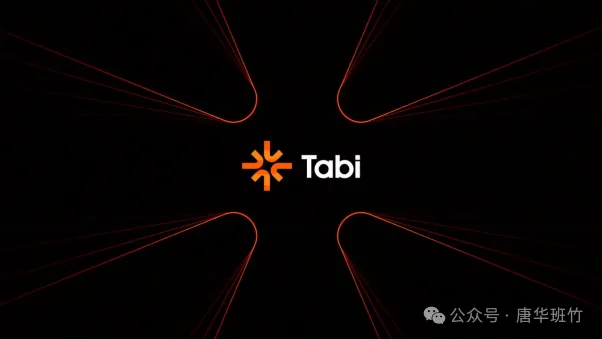
On the other hand, it has introduced a new Gaming 33 economic model. Through this dual-value flywheel system, it can build an external incentive layer without changing the internal economic model of the game, allowing the community, game developers, and Tabi Chain ecology to be deeply bound, and ensuring game quality, user experience, and ecosystem development, which is of great significance for pushing high-quality games out of the death spiral.
Tabi Chain represents a new paradigm for a new generation of blockchain gaming infrastructure and is expected to push the blockchain gaming sector into the “2000 moment”.
The sustainability problem of blockchain gaming
The blockchain gaming sector is a potential narrative that has attracted much attention. We see that more and more developers are inclined to explore this field. On the bright side, the infrastructure for blockchain gaming is being continuously upgraded in technology, and some underlying platforms that specifically serve blockchain gaming applications have emerged, such as Immuatable X, WAX, Klaytn, Ronin, etc.
However, we have seen that although further technological innovations in infrastructure have brought certain help to the playability and user experience of blockchain games, there is still an extremely high entry barrier for developers, especially traditional game development teams. Some potential obstacles may include structural differences between Web3 applications and traditional software, design limitations of smart contracts, limitations on data storage and calls, asset integration, etc., which also makes it difficult for the blockchain game field to be innovated at the source.
Similarly, the limitations of industry infrastructure are also a major obstacle to the development of the blockchain gaming sector.
On the basis of adhering to the existing blockchain technology solution, if all the elements of the game are embedded on the chain, every transaction made by the player in the game will be a transaction. The player may need to sign a transaction for each step of the operation, pay a gas fee, and wait for the mobile log to be "finalized", which will also cause "stuttering" in the game loop. At the same time, there are certain limitations on the blockchain itself. When the on-chain behavior load is too high, the transaction cost soars, the transaction efficiency plummets, and has a direct impact on the game. For example, not long ago, the inscription market exploded and many on-chain transactions soared, which stripped the underwear of a number of Layer 2 and EVM compatible chains. So for now, even if many games rely on centralized servers as the underlying stack, the existing industry facilities are also difficult to support many large-scale games with complex interactive logic and a large user base. So for now, most blockchain game rooms lack playability.
On the other hand, although further innovation of the underlying infrastructure has limited help in the sustainable development of blockchain games, most blockchain games still find it difficult to escape the curse of the death spiral. In fact, most blockchain game infrastructure solutions often expect to solve problems from a purely technical perspective through technological upgrades and innovations, bringing better performance and experience support to the games in their ecosystem, but basically ignore their support for the economic level of game applications within the ecosystem. Therefore, from the perspective of blockchain games as a whole, the community, game developers, and game chains are seriously out of touch, resulting in insufficient synergy and difficulty in fully utilizing the utility of tokens.
Therefore, when the game itself is not attractive to players in terms of gameplay and lacks a reasonable economic model, the game is usually difficult to survive in the long run. Developers usually find it difficult to make sustained profits except for early token sales, and players will fall into a death spiral due to token incentives and have to withdraw.
We have seen that as the last round of bull market came to an abrupt end due to several black swan events, the blockchain gaming sector has also begun to cool down. We have seen that both Axie Infinity, the leader of GameFi at the time, and many public game chains that performed well in the last round of GameFi boom, have shown a scene of deserted visitors.
How does Tabi Chain push blockchain gaming out of the “quagmire”?
Tabi Chain is a blockchain game chain built on Cosmos. It is also the first game-specific chain in the ecosystem with EVM compatibility.
One of the technical innovations of Tabi Chain lies in its all-round execution layer solution, which allows each game or dApp to build its own independent Service as an independent environment for the application to run. All Services submit the blocks they generate to the consensus system of the chain, and the Supervisor Nodes in the network perform status verification, which provides a highly flexible, customized, scalable, secure and efficient environment for the operation of the application.
The all-around execution layer solution is based on the Polymorphism VM solution (a VM with polymorphic capabilities). Through the design of a modular execution environment, it makes the compilation of smart contracts more universal, allowing developers to freely write and deploy smart contracts on different virtual machines. By supporting multiple programming languages and smart contract models, it can attract a wider developer community. Polymorphism VM is highly customizable, especially for Web2 developers. They can use their familiar languages and frameworks to port any business logic to Polymorphism VM. For example, developers familiar with Java language and framework can still develop on-chain based on this language and adapt and deploy through Polymorphism VM. This universal design is greatly lowering the threshold for smart contract development. On-chain development can be like Web2 game developers based on cross-platform front-end engines such as Unity. A set of code can be slightly adapted to run on different environments such as iPhone, Android, and desktop.
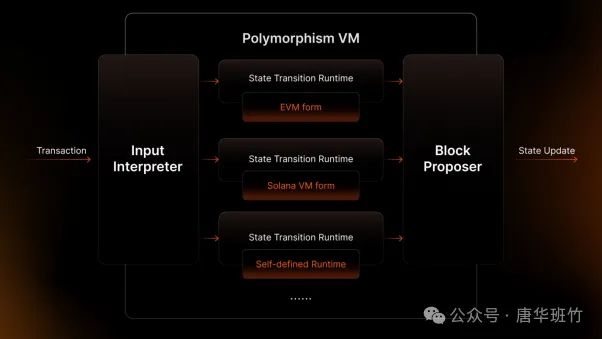
At the same time, Tabi Chain also provides developers with a series of customized components to enhance the user experience, including the choice of Gas mode to reduce the high costs caused by frequent signing and other behaviors; including a variety of optional login methods from wallets and traditional ID & passwords to WebAuthn, etc.
In order to achieve better on-chain burstability, Tabi Chain shards the execution layer and builds ParallelIBFT consensus, which greatly improves the network's throughput and transaction processing speed by implementing parallel block proposals for all service nodes in the DAG block structure. Within each service, the service node uses the parallel HotStuff consensus algorithm, achieving a four-fold speed increase over the traditional consensus solution.
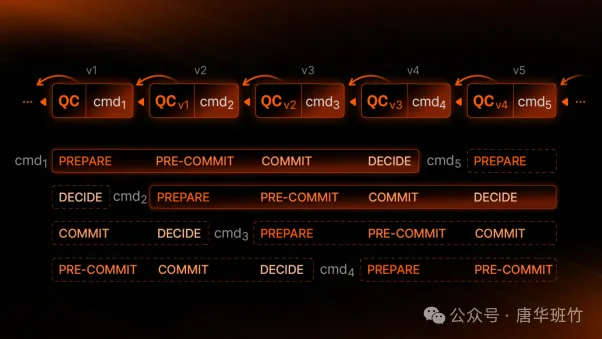
Tabi Chain has input transparency, public visibility of state transitions, and the ability to express global states. It removes the Merkle tree structure, further improving performance by more than 100 times, with a single server TPS of more than 100,000, making game operations smoother and more efficient. By establishing a high degree of interoperability with other chains in the Cosmos system through the IBC protocol, Tabi Chain can also bring a rich variety of assets to ecological applications and is expected to quickly establish a TVL scale.
As a PoS ecosystem, Tabi Chain’s security comes from EigenLayer. Supervisor nodes and Service nodes need to stake on EigenLayer and monitor any malicious activities such as double-signed blocks based on the AVS established on EigenLayer. At the same time, as a modular chain, Tabi Chain’s security also comes from Ethereum.
As a blockchain underlying infrastructure, Tabi Chain not only builds a set of underlying infrastructure suitable for all developers, provides a high-burst operating environment for games and has high security, but its other major "weapon" lies in an economic system with a double-value flywheel effect, namely Gaming 33.
Gaming 33: The “Fourth Industrial Revolution” of Web3 Games
In fact, in the traditional blockchain game ecosystem, the bottom layer of the chain usually does not participate in the economic system of its ecological application. These game-oriented blockchains usually only focus on game publishing.
The relationship between users and games is usually based on the "Earn" mechanism, which establishes a "one-time" link with users. When the incentive of a single token decreases, users lose stickiness. Some fees (Gas, etc.) generated by users through games are usually only used as chain income, and will not flow to developers and users. From the perspective of developers, in order to obtain income, they can only hope to sell tokens or NFTs. The disconnection between the interests and incentives of the chain ecology, game applications themselves, and communities hinders the quality of games, user experience, and the development of the ecosystem.
Tabi Chain's Gaming 33 is an important economic mechanism of the ecosystem. It is built on the basis of $TABI, with the "one coin, three states" mechanism as the core, aiming to provide a set of incentives to enhance tokens without affecting the game economy, so that the community, game developers and Tabi Chain can form a close connection. In this system, users will continue to increase their income by participating in the selection of high-quality games, and high-quality games will become more motivated by being selected by more users, and developers will get more income and resources, so that the ecological game system will continue to select the best, and based on this, the overall moat of the game ecology will be continuously improved.
1. "One coin, three states"
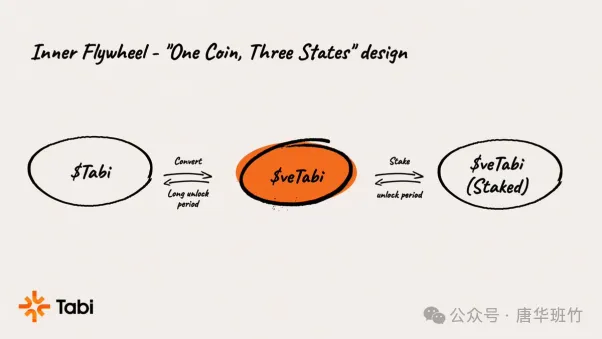
2. Vote Bribery: The Battle for Game Resources
In 2021, Curve took the voting(ve) custody model a step further by launching v2. One of the main powers given to veCRV holders is the ability to change the amount of CRV rewards allocated to each pool on Curve, which was also the trigger for all projects to participate in the Curve War.
For some projects that build pools on Curve, they need to have enough voting rights to obtain higher APY to motivate potential LPs to seize more market resources. Voting rights require continuous accumulation of CRV and conversion into veCRV to obtain. After the launch of this model, more and more DAOs and DEXs, including Convex, Yearn, StakeDAO, etc., have joined the "war" and have attracted CRV holders by offering attractive APYs. The platform will then deposit the received CRV into Curve for locking and collecting veCRV, thereby obtaining voting rights and allocating more CRV rewards to the mining pools for which they provide liquidity. Curve obtains voting rights by locking CRV to determine where the proceeds go.
Tabi Chain also adopts a similar mechanism. In this system, games on the chain will compete for voting rights, which attracts users to stake their $veTABI tokens in the form of $veTABI (Staked) to their favorite games. As more users stake and vote, games will receive more rewards and funding allocations (from Tabi Chain's Gas and other system income) from the Tabi Chain ecosystem as developer income, and will be able to provide more rewards to users.
From the user's perspective, when choosing, they usually prefer to choose high-quality games that they think are better and have more development potential, because this is linked to their potential incentive benefits, and users voting for them may also promote users to become in-depth participants. This will promote higher-quality games to get more votes, and in turn, the allocation of Tabi Chain resources will provide users with higher incentives and attract more users to vote for them.
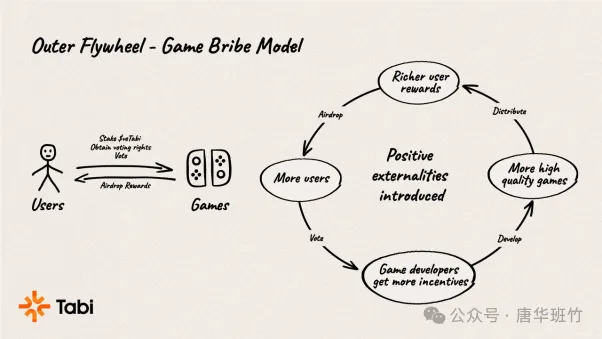
Therefore, Chain’s bribery model provides a “competition” mechanism, through which ecological games can obtain better resource allocation, incentive rights and income from the Tabi Chain governance system, compete for resources and form an external value flywheel, helping its game ecology to continuously select the best.
In this way, Tabi Chain delegates the right to choose games and allocate resources to the community, rather than having the chain (or the foundation behind it) decide itself, while establishing a better organic link between the community, game developers, and the underlying chain.
3. Double Value Flywheel
Based on this governance system, Tabi Chain is able to establish a dual-value flywheel.

Inner flywheel:
With the operation of the vote-buying mechanism, good games can attract more users to participate in voting through considerable incentives, which will directly promote the market demand for $TABI, $veTABI and staking demand, because more staking can bring more rewards, which will provide potential for the continuous rise of $TABI tokens. The rise of $TABI tokens will encourage more users to participate in staking and convert to $veTABI. While obtaining $veTABI interest income, it will promote more $TABI tokens to participate in the Tabi Chain economic system, increase the rigid demand for $TABI, reduce its external market circulation, and stimulate the transaction volume of $TABI.
As the internal flywheel continues to run, it will continue to empower the value of $TABI.
Outer flywheel:
As mentioned above, high-quality games can obtain better resource allocation from Tabi Chain by attracting more users to vote. Developers can earn considerable income from it and continuously improve the incentive level to attract more users to vote for them and attract more developers to participate in the construction of the Tabi Chain ecosystem.
Based on this system, good game content can attract more user traffic and funds from the network and obtain better development opportunities. At the same time, it will also continue to help the network identify which games have the potential to become popular games.
The dual flywheel system will continuously enhance the Tabi Chain ecological moat, and continuously build a more solid value foundation and consensus system, and ultimately promote the entire Web3 gaming ecosystem to a new paradigm. Its new Gaming 33 solution is also known as the "fourth industrial revolution" of Web3 gaming.
The “2000 Moment” in Blockchain Gaming
The year 2000 was an important moment in the development of traditional Internet. In 2000 and the following years, Internet infrastructure, especially broadband technology, was greatly improved and popularized. At the same time, with the rapid development of the Internet economic system, Internet developers were able to benefit from the new economic system and business model, which promoted the vigorous development of the Internet field and
It laid an important foundation for its development to the next stage.
In fact, Tabi Chain is also known as an important driving force for the blockchain gaming field to move towards the "2000 moment".
Tabi Chain provides a more complete infrastructure for the blockchain game field through a series of innovative technical solutions. On the one hand, it greatly improves the performance and scalability of chain facilities, providing blockchain games with an operating environment that can match their needs. At the same time, through its all-round execution layer solution and modular architecture system, developers can participate in the exploration and development of the blockchain game field with a very low threshold, providing an important foundation for the blockchain game field to continuously capture fresh blood. Blockchain games are also expected to be comparable to traditional Web2 games in terms of gameplay and experience.
With the support of the Gaming 33 governance mechanism, high-quality developers will be able to obtain better resource allocation and incentives, and users will continue to receive incentives for helping the network screen high-quality game applications. The income at the bottom of the chain will continue to feed back to high-quality developers, the game ecosystem, and users, continuously driving the operation of the value flywheel.
Focusing on the $TABI token itself, the overall narrative of the ecosystem is establishing its position as the number one blockchain game + public chain concept asset.
On the one hand, as a public chain concept token, it not only represents the Tabi Chain game system, but also is the core of Tabi Chain on-chain functional token and ecological governance. It is an important economic foundation for the ecosystem to build a powerful game infrastructure. It can be deeply empowered with the continuous circulation of external value and internal value.
On the one hand, it is a conceptual asset in the gaming track. It not only runs through every game in the ecosystem, but will also be continuously empowered as each game develops. Therefore, the $TABI token itself has a very high imagination space and continues to have an upward spiral of value. As $TABI is based on the grand narrative of public chain + game, it will also have a great imagination space in valuation.
With the promotion of the Tabi Chain system, the form of blockchain games is expected to develop in a new direction, and blockchain game players are expected to further change their worldview, and the field is expected to move towards the "2000 moment".